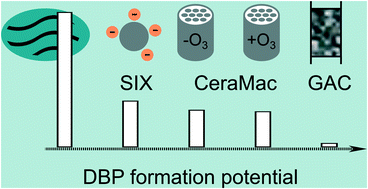当前位置:
X-MOL 学术
›
Environ. Sci.: Water Res. Technol.
›
论文详情
Our official English website, www.x-mol.net, welcomes your feedback! (Note: you will need to create a separate account there.)
Selective removal of natural organic matter during drinking water production changes the composition of disinfection by-products
Environmental Science: Water Research & Technology ( IF 5 ) Pub Date : 2020/01/21 , DOI: 10.1039/c9ew00931k Anna Andersson 1, 2, 3, 4 , Elin Lavonen 4, 5, 6, 7, 8 , Mourad Harir 9, 10, 11, 12, 13 , Michael Gonsior 14, 15, 16 , Norbert Hertkorn 9, 10, 11, 12 , Philippe Schmitt-Kopplin 9, 10, 11, 12, 13 , Henrik Kylin 1, 2, 3, 4, 17 , David Bastviken 1, 2, 3, 4
Environmental Science: Water Research & Technology ( IF 5 ) Pub Date : 2020/01/21 , DOI: 10.1039/c9ew00931k Anna Andersson 1, 2, 3, 4 , Elin Lavonen 4, 5, 6, 7, 8 , Mourad Harir 9, 10, 11, 12, 13 , Michael Gonsior 14, 15, 16 , Norbert Hertkorn 9, 10, 11, 12 , Philippe Schmitt-Kopplin 9, 10, 11, 12, 13 , Henrik Kylin 1, 2, 3, 4, 17 , David Bastviken 1, 2, 3, 4
Affiliation

|
Disinfection by-products (DBPs) are potentially toxic compounds formed upon chemical disinfection of drinking water. Controlling the levels and characteristics of dissolved organic matter (DOM) as precursor material for DBPs is a major target to reduce DBP formation. A pilot-scale treatment including suspended ion exchange (SIX®), a ceramic microfilter (CeraMac®) with in-line coagulation and optional pre-ozonation followed by granular activated carbon (GAC) filtration was compared with a conventional full-scale treatment based on DOM removal and DBP formation using Fourier transform ion cyclotron resonance mass spectrometry (FT-ICR MS), rapid fractionation, liquid chromatography organic carbon detection (LC-OCD), adsorbable organic halogens (AOX) and trihalomethane (THM) analysis. The new treatment combination showed different selectivity for DOM removal, compared to the conventional, leading to changes in composition of the DBPs formed. SIX® and GAC had the largest impacts on reducing AOX and THM formation potentials but the high adsorptive capacity of GAC affected the diversity of detected DBPs most. Chlorination and chloramination of pilot treated water with doses normally used in Sweden produced low levels of AOX compared to the full-scale treatment, but FT-ICR MS revealed an abundance of brominated DBP species in contrast with the conventional treatment, which were dominated by chlorinated DBPs. This finding was largely linked to the high DOM removal by the pilot treatment, causing an increased Br−/C ratio and a higher formation of HOBr. Potential increases in Br-DBPs are important to consider in minimizing health risks associated with DBPs, because of the supposed higher toxicity of Br-DBPs compared to Cl-DBPs.
中文翻译:

在饮用水生产过程中选择性去除天然有机物改变了消毒副产物的组成
消毒副产物(DBP)是在饮用水化学消毒后形成的潜在有毒化合物。控制作为DBP前体材料的溶解有机物(DOM)的水平和特性是减少DBP形成的主要目标。将基于悬浮离子交换(SIX®),具有在线凝结和可选的预臭氧处理,然后进行颗粒活性炭(GAC)过滤的陶瓷微滤器(CeraMac®)的中试处理与基于常规全处理的处理进行了比较傅里叶变换离子回旋共振质谱(FT-ICR MS),快速分馏,液相色谱法有机碳检测(LC-OCD),可吸附有机卤素(AOX)和三卤甲烷(THM)分析对DOM的去除和DBP的形成进行了研究。与常规处理相比,新的处理组合显示出不同的DOM去除选择性,导致形成的DBP组成发生变化。SIX®和GAC对降低AOX和THM形成潜能的影响最大,但GAC的高吸附能力对检测到的DBP的多样性影响最大。与全面处理相比,在瑞典通常使用的中试处理水的氯化和氯化处理产生的AOX含量较低,但是FT-ICR MS与传统处理相比,溴化DBP种类丰富,而氯化处理占主导地位DBP。这一发现主要与通过先导处理去除的高DOM有关,导致Br增加 SIX®和GAC对降低AOX和THM形成潜能的影响最大,但GAC的高吸附能力对检测到的DBP的多样性影响最大。与全面处理相比,在瑞典通常使用的中试处理水的氯化和氯化处理产生的AOX含量较低,但是FT-ICR MS与传统处理相比,溴化DBP种类丰富,而氯化处理占主导地位DBP。这一发现主要与通过先导处理去除的高DOM有关,导致Br增加 SIX®和GAC对降低AOX和THM形成潜能的影响最大,但GAC的高吸附能力对检测到的DBP的多样性影响最大。与全面处理相比,在瑞典通常使用的中试处理水的氯化和氯化处理产生的AOX含量较低,但是FT-ICR MS与传统处理相比,溴化DBP种类丰富,而氯化处理占主导地位DBP。这一发现主要与通过先导处理去除的高DOM有关,导致Br增加 与全面处理相比,在瑞典通常使用的中试处理水的氯化和氯化处理产生的AOX含量较低,但是FT-ICR MS与传统处理相比,溴化DBP种类丰富,而氯化处理占主导地位DBP。这一发现主要与通过先导处理去除的高DOM有关,导致Br增加 与全面处理相比,在瑞典通常使用的中试处理水的氯化和氯化处理产生的AOX含量较低,但是FT-ICR MS与传统处理相比,溴化DBP种类丰富,而氯化处理占主导地位DBP。这一发现主要与通过先导处理去除的高DOM有关,导致Br增加- / C比和更高的HOBr形成率。Br-DBPs的潜在增加对于最小化与DBPs相关的健康风险非常重要,因为Br-DBPs的毒性比Cl-DBPs高。
更新日期:2020-03-05
中文翻译:

在饮用水生产过程中选择性去除天然有机物改变了消毒副产物的组成
消毒副产物(DBP)是在饮用水化学消毒后形成的潜在有毒化合物。控制作为DBP前体材料的溶解有机物(DOM)的水平和特性是减少DBP形成的主要目标。将基于悬浮离子交换(SIX®),具有在线凝结和可选的预臭氧处理,然后进行颗粒活性炭(GAC)过滤的陶瓷微滤器(CeraMac®)的中试处理与基于常规全处理的处理进行了比较傅里叶变换离子回旋共振质谱(FT-ICR MS),快速分馏,液相色谱法有机碳检测(LC-OCD),可吸附有机卤素(AOX)和三卤甲烷(THM)分析对DOM的去除和DBP的形成进行了研究。与常规处理相比,新的处理组合显示出不同的DOM去除选择性,导致形成的DBP组成发生变化。SIX®和GAC对降低AOX和THM形成潜能的影响最大,但GAC的高吸附能力对检测到的DBP的多样性影响最大。与全面处理相比,在瑞典通常使用的中试处理水的氯化和氯化处理产生的AOX含量较低,但是FT-ICR MS与传统处理相比,溴化DBP种类丰富,而氯化处理占主导地位DBP。这一发现主要与通过先导处理去除的高DOM有关,导致Br增加 SIX®和GAC对降低AOX和THM形成潜能的影响最大,但GAC的高吸附能力对检测到的DBP的多样性影响最大。与全面处理相比,在瑞典通常使用的中试处理水的氯化和氯化处理产生的AOX含量较低,但是FT-ICR MS与传统处理相比,溴化DBP种类丰富,而氯化处理占主导地位DBP。这一发现主要与通过先导处理去除的高DOM有关,导致Br增加 SIX®和GAC对降低AOX和THM形成潜能的影响最大,但GAC的高吸附能力对检测到的DBP的多样性影响最大。与全面处理相比,在瑞典通常使用的中试处理水的氯化和氯化处理产生的AOX含量较低,但是FT-ICR MS与传统处理相比,溴化DBP种类丰富,而氯化处理占主导地位DBP。这一发现主要与通过先导处理去除的高DOM有关,导致Br增加 与全面处理相比,在瑞典通常使用的中试处理水的氯化和氯化处理产生的AOX含量较低,但是FT-ICR MS与传统处理相比,溴化DBP种类丰富,而氯化处理占主导地位DBP。这一发现主要与通过先导处理去除的高DOM有关,导致Br增加 与全面处理相比,在瑞典通常使用的中试处理水的氯化和氯化处理产生的AOX含量较低,但是FT-ICR MS与传统处理相比,溴化DBP种类丰富,而氯化处理占主导地位DBP。这一发现主要与通过先导处理去除的高DOM有关,导致Br增加- / C比和更高的HOBr形成率。Br-DBPs的潜在增加对于最小化与DBPs相关的健康风险非常重要,因为Br-DBPs的毒性比Cl-DBPs高。


























 京公网安备 11010802027423号
京公网安备 11010802027423号